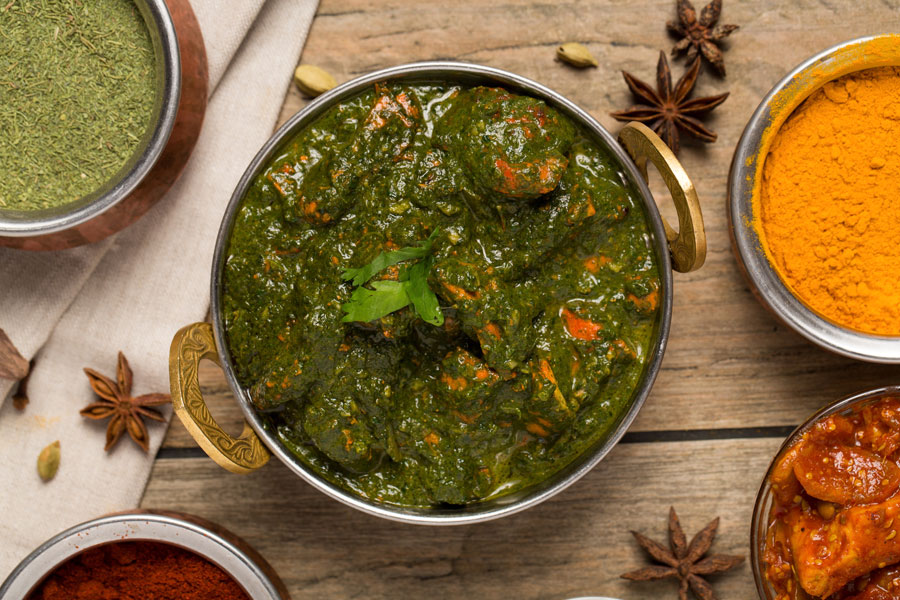There’s a huge difference between an astounding curry and an underwhelming one. Indian food is famous for being full of flavour, and there are a few tricks you can take on board to make curries taste amazing. If all this sounds too hard, come and try a curry at Coriander’s – our chefs are masters of the art and these techniques are second nature to them!
1. Use lots of spices
Don’t let those little cardboard boxes from the supermarket guide how much spice you use. Go to a proper Indian supermarket or bulk foods store and get some decent containers of your favourite spices. And any recipe that tells you to use a “pinch” of spices in your curry is not to be trusted. Spices are flavour, so don’t be shy with them!
2. Good oil
Oil picks up the flavour of the spices and carries it through your curry. It also makes the texture thicker and the flavour richer. Many curries benefit from frying whole spices like cardamom pods or cumin seeds in oil before adding the other ingredients, or from adding spice powders when frying the onions. Using lots of oil can make for a heavy “special occasion” curry. If you want a lighter meal, use less oil but make sure it’s of good quality. We often use a mixture of ghee (Indian clarified butter) and high-quality vegetable oil. Ghee is not used in vegan dishes.
3. Root causes
Many curries contain ginger or onion, and some contain garlic. These roots and bulbs have lots of flavour and can also add texture to your curry. They should be carefully cooked to release their flavours without burning. Onions can sometimes be added near the end of cooking for a fresher flavour and crisp feel.
4. Bulk it up with fresh ingredients
Curries contain a main body ingredient that gives them bulk, flavour and a saucy feel. This is often made with tomato, spinach, other vegetables, cream or coconut milk. This is essentially the main ingredient of the curry, so it’s important to use high-quality ingredients. Fresh, locally-sourced vegetables and quality cream are key.
5. The main event
If adding meat to your curry, go for the good stuff. It doesn’t have to be the most expensive cut (many cheaper cuts of meat taste better than the fancy stuff when slow-cooked in a curry), but it should at least be quality butcher’s meat rather than bulk supermarket stuff. You want your meat to cook well rather than disintegrating, and you want it to remain juicy and tender instead of drying out or shrinking. At Coriander’s we have a delicious range of vegan meals, where we use an innovative soy product as the protein element of the meal. These large, firm soy pieces have great texture and leave you feeling satisfied.
6. Time
This is one of the most important elements for making many curries: slow cooking. While some curries are cooked fresh over a hot flame, many of the best ones benefit from several hours of low, slow cooking that brings out the flavour of the spices and vegetables, and makes the meat tender and juicy. Aim for a slow simmer – you don’t want it to be too hot or it will overcook. You can eat the curry at any stage once it’s cooked, but the longer you leave it (up to a point) the more flavourful and thick it will be. If you haven’t got time for that, the good news is we’ve got plenty of time at Coriander’s to make the perfect slow-cooked curries, ready for you to order and eat!
7. Perfect seasoning
Remember all the spices we added at step 1? That’s completely wasted if you don’t season your curry properly. You could add literal handfuls of spice and your curry would still taste bland if you don’t have a little salt in there. Salt is an enhancer that brings out the flavour of other ingredients. Don’t oversalt though! Pro tip: Add salt bit by bit and taste as you go. Let the curry cool down on the spoon before tasting – it’s difficult to taste anything in very hot liquid.
For a guaranteed great curry, order from corianders.co.nz – we deliver around Christchurch, with dine in, pick up and Uber Eats options available.




